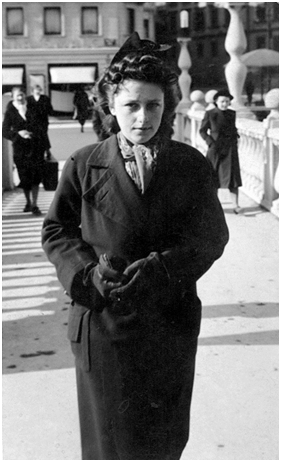MAJDA KURNIK
(1920-1967)
Fifty years have passed since the death of Majda Kurnik, the painter. Slovenia did not know well this exceptional paintress and intellectual, who had many artistic talents – for music, acting and painting. She chose painting. One can conclude on the basis of the facts from her life and the preserved documents, now kept in the Majda Kurnik Collection of Gallery Velenje, that her life, spent far from her family, was divided. Her family roots were deeply set in Šaleška and Gornja Savinjska valley in Slovenia, while she began her artistic development in the School of Painting run by Mladen Josić. Later she enrolled the Academy of Fine Arts in Belgrade (today, the Faculty of Fine Arts).
The Second World War deeply affected Majda Kurnik and her family. She first lost her brother and then her sister and she became a member of the Propaganda department of the Third Army and the only woman painter in that department. In her drawings and paintings she recorded the happenings on the front and around it. Each paper she could lay hands on she ennobled with figures, objects, landscapes and imbued with an artistic form.
After the war she continued with the same activity during the voluntary youth work assignments transporting them through her notes into history.
We can suppose that some sketches were made in Slovenia before her move to Serbia. However, the first public presentation of her works was of those produced during the Second World War. In improvised hospitals, at the front or in the rear, she drew faces and scenes that are precious not only because they are valuable documents of her work but also because as artistic records of a sad history. Her sovereign strokes in pencil or coal recorded numerous tragic, emotional or joyful events during the battles, during short intervals for rest or nursing, happening in the unpredictable circumstances of the war period. Until the end of the war, her works were predominantly made on paper, in pencil, coal, Indian ink, sepia, watercolour or gouache. She set on her journeys abroad thanks to the support and help of her parents, first to Rome and then to Venice. After Italy, she went to Paris, and this had a direct impact on her works produced in the style of the School of Paris (École de Paris).
Majda Kurnik found her objective and living space in Belgrade, among her friends painters, designers, poets, composers and publicists. Together with the painters and sculptors she took part in many exhibitions of the Association of Serbian Artists (ULUS) in Belgrade and other places.
Encounters with her works stirred many memories and recollections of both connoisseurs and amateurs. Undoubtedly, she was appreciated by everybody; the Slovenes respected her like a relative, the Serbs as an excellent paintress who had been formed in their milieu.
Every drawing, sketch and painting were painted with full energy and imbued with the spirit of the object. Even today this shows the unerring character of her intuitive creative imagination. The spiritual intensity of the people in her portraits or as individual members of groups were drawn with the conviction of the most visible characteristics of their physiognomies and the overall language of their faces and bodies. It is possible to recognise in some of them the portraits of her colleagues with whom she spent a lot of her working time and leisure. The figures appearing in still-lifes are subjected to the painterly atmosphere and much closer to literary than painterly elements. In her creative work she obviously followed the rules of painting and feelings and not rational thoughts. However, somewhere behind all this one can sense a part of her self that lived and sympathised with Slovenia, particularly in her landscapes which she never clearly defined.
Majda Kurnik was much inspired by the dramatic intimism of El Greco, the master of mannerism, who had arrived from the Renaissance idealism just as Majda had come from socialist realism. With her refined feeling she drew the most deeply kept secrets of life and of the painterly spell. A special attention should be afforded to miniature gouaches which she made whenever she had a chance. Every piece of cardboard, even if it were cigarette boxes, always by her side since she was a passionate smoker, she would use for minimalist gouaches equal in their painterly quality to big paintings.
Sleepwalkers, flying figures and animals, devils, frightening beasts as symbols of cosmogony appear in the last four years of her life, after her illness had been diagnosed.
Since the appearance of those figures grew sadder, her painterly ascent became more visible. Her specific testament is the last phase of her paintings with cosmic abstractions.
The Gallery Velenje will fastidiously and proudly keep and show her works.
Milena Koren Božiček, MA, curator in the Gallery Velenje
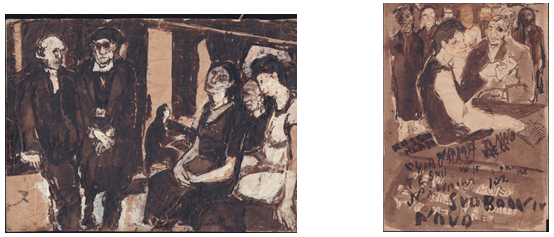
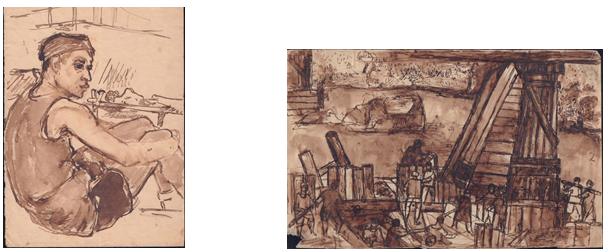

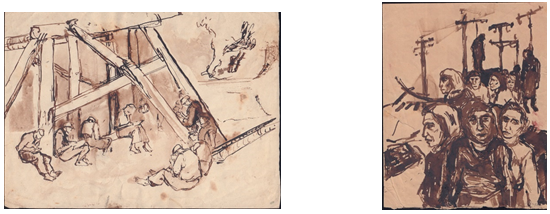
Crteži malog formata sa tematikom: iz rata, izgradnje, života, pejzaža / Small-format drawings with scenes from the war, rebuilsing of the country, real life, or countryside
Majda Kurnik (1920-1967) was a Slovene by birth, but a Serbian paintress by formation, sensitive, strong, temperamental, modest and courageous and today – five decades after her death – she is almost forgotten. However, her work evidently has a safe place in the Serbian history of art, although the general public cannot see her paintings (except two paintings in the collection of the ZEPTER MUSEUM) . Her name is well-known to the older generation (and they easily remember her) but it has remained completely unknown to the young ones, except if they find a reproduction somewhere or remember to „open“ Wikipedia.
The artworks by this specific artist have not yet been sufficiently researched and therefore not evaluated correctly. The works that have remained behind show an effort to collate her visions of a full, liberated life with the dull echoes of the moments spent in illness, as Stojan Ćelić (catalogue of the posthumous exhibition „Majda Kurnik“ 1968 in the Art Pavilion Cvijeta Zuzorić) put forward in his most touching but also most impartial text about her creative activity of less than twenty years.
Majda Kurnik came to Belgrade in 1941 exiled by the occupiers and attended Josić’s School of Painting. In 1945 she joined the National Liberation movement on the Sirmian front and graduated from the Academy of Fine Arts (presently Faculty of Fine Arts) in 1949 in the class of professors Tabaković, Petrov and Čelebonović.
Hundreds of drawings have remained after her death and to a dedicated researcher they could reveal all the details hidden in her paintings. The drawings made at the Sirmian front disclose that Majda Kurnik had already mastered all the skills future students at the Academy had yet to deal with. Her drawings done in diluted ink and made at the voluntary youth work assignments confirm a mature artist who was able to structure the composition of the scene in a masterly way. The firm architecture of those „crowd scenes“ in natural ambience unambiguously suggest the monumentality she was not able to attain in her paintings. The dynamics here, eloquent almost to auditory effect was silenced in the paintings to the level of a specific melancholy. A rather big, partially coloured drawing from a boulevard in Paris suggest the direction Majda Kurnik could have taken had she not decided otherwise.
She adopted the interpretation of the meaning of a picture that followed the real values of tradition and gradually modernised her expression thus changing the sense of the surrounding real world that was the true subject matter of her paintings. She never made radical steps out or forward. When she was working in plein air her motifs were the architecture of monasteries and the countryside, when working in her studio she painted the everyday objects scattered around. At the beginning of the sixties she turned to the figure. Approaching the end of her life she was more interested in female and male nudes, and would gradually replace the figures of bathers and masons with floating figures in a blue-grey gamut. Nevertheless, throughout her opus the changes in her approach to the painting can be followed most accurately through her still-lifes and self-portraits. As years went by the dynamic and expression became stronger: the aspect had surpassed visibility. It finally became clear that the painter had travelled the road from objects to relationships and that still-lifes and self.-portraits were in fact representations of states and dispositions.
The loneliness of Majda Kurnik, despite sociable inclinations emphasised by her friends, was proven in the best possible way by the dull light in her always closed pieces of fruit in still-lifes, walnuts, chestnuts, dried pomegranates… As if she was saying: That is me, I saw myself in that way one day in the dim light of my studio, or the room in Zadarska Street.
Therefore, we have no right to define her as a painter of objects. She was a true figurative painter because the figure is an object remembered – the symbol of an object and its meaning. It is about the effort to prevent the feelings and experiences to remain within the limited space of isolated things. For that very reason Majda Kurnik needed only a table cloth with scattered chestnuts to convey what she wanted to communicate. It is sufficient because it is not about the objects, but about the meaning. And meaning does not pose.
Savo Popović
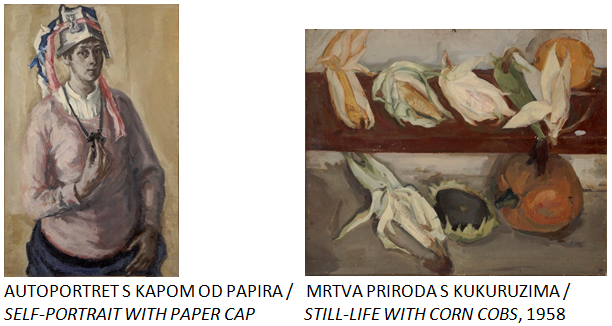

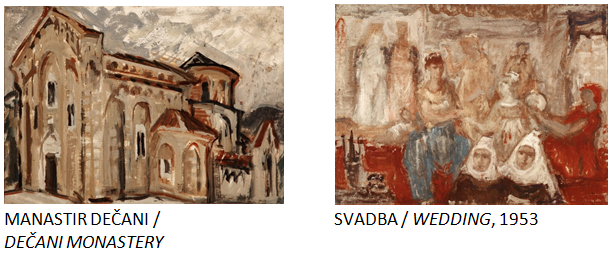




Crteži malog formata sa tematikom: iz rata, izgradnje, života, pejzaža / Small-format drawings with scenes from the war, rebuilsing of the country, real life, or countryside
Majda Kurnik (1920 – 1967) Slovenka po rodjenju, srpska slikarka po formaciji, osećajna, snažna, temperamentna, skromna i hrabra i danas je – pet decenija od smrti bezmalo posve zaboravljena. Međutim, njeno delo sasvim izvesno ima svoje osigurano mesto u srpskoj istoriji umetnosti. Ipak, njene slike publika nema gde da vidi (osim dve slike u stalnoj postavci MUZEJ-a ZEPTER). Starijoj generaciji ono je poznato (lako ga prizovu u sećanju), mladima ostaje u potpunosti nepoznato, sem ako, tu i tamo ne naiđu na neku reprodukciju ili se sete da „otvore“ vikipediju.
Stvaralaštvo ove osobne umetnice još uvek nije osvetljeno u dovoljnoj meri, a samim tim ni na pravi način valorizovano. U onome što je ostalo od dela vidljiv je napor da se konačno spoje njene vizije punog, oslobođenog života s muklim odjecima odbolovanih trenutaka, ističe Stojan Ćelić (katalog posthumne izložbe „Majda Kurnik“ 1968. Umetnički paviljon „Cvijeta Zuzorić“) u najdirljivijem ali i najobjektivnijem tekstu kad je reč o njenom stvaralaštvu koje je trajalo nepune dve decenije.
U Srbiju, Beograd dolazi 1941. kao prognanik okupatora i u prestonici pohađa Josićevu slikarsku školu, potom od 1945. učestvuje u NOB-u na Sremskom frontu. Akademiju likovnih umetnosti (dans Fakultet likovnih umetnosti) završava 1949. u klasi Tabakovića, Petrova i Čelebonovića.
Iza slikarke su ostale stotine crteža koji bi posvećenom tragaocu otkrili sve ono što je zatomljeno u slikama. Naime crteži sa Sremskog fronta otkrivaju da je Kurnikova savladala sve veštine koje predstoje budućim studentima Akademije. Potom lavirani crteži sa radnih akcija svedoče da je reč o zrelom stvaraocu koji maestralno gradi kompoziciju prizora. Čvrsta arhitektura tih „masovki“ u prirodnom ambijentu nedvosmisleno sugeriše monumentalnost koja nije dosegnuta na slikama. Dinamika ovde sugestivna bezmalo do zvuka potom će na slikama biti utišana do svojevrsne melanholije. Posebno će jedan oveći delimično obojeni crtež sa nekog pariskog bulevara nagovestiti smer kojim je Majda Kurnik mogla da krene da nije drugačije odlučila.
Međutim, ona se priklonila onom shvatanju slike koje se oslanja na prave vrednosti tradicije ali je postepeno osavremenjavala izraz i na tom putu menjala smisao realnog sveta koji ju je okruživao i bio tema njenih slika. Nije pravila radikalne iskorake. Motiv je bio arhitektura manastira ili pejzaž kad je bila na terenu i svakidašni predmeti iz njenog okruženja koji su se zatekli u ateljeu. Potom se, početkom sedme decenije, više okreće figuri. U tom sledu putujući sopstvenom kraju aktove žena i muškaraca, kupače i zidare zameniće postepeno lebdeće figure u plavo-sivoj gami. Dramatiku pikturalnog izraza smenjuje dramatičnost motiva. Pa ipak, kroz čitav njen opus mene u pristupu slici mogu se pratiti najpre kroz mrtve prirode i autoportrete. Ekspresija i dramatika dobijaju na težini kako godine odmiču: vid je nadmašio vidljivost. Postalo je konačno jasno da je slikarka prešla put od stvari ka odnosima i da se u tim mrtvim prirodama kao i u autoportretima radilo o prikazu stanja i raspoloženja.
Osamljenost Majde Kurnik, uprkos društvenosti koju u sećanjima ističu njeni prijatelji, pečati ponajbolje mukla svetlost na njenim uvek zatvorenim plodovima na mrtvim prirodama, na orasima, na kestenju, sasušenim narovima… Kao da kaže: To sam ja, jednog dana sam se tako videla u polusvetlu ateljea, ili te sobe u Zadarskoj ulici.
Dakle nemamo pravo da je odredimo predmetnim slikarom. Ona je pravi figurativac, jer figura je predmet u sećanju – simbol predmeta i njegovog značenja. Radi se o naporu da se osećaji i iskustva ne zaustave na ograničenosti pojedinačnog, pa upravo zato je Majdi Kurnik za sve što hoće reći dovoljan jedan stolnjak i na njemu prosuto kestenje. A dovoljno joj je zato što se ne radi o predmetima nego o značenju. A značenje ne pozira.
Savo Popović

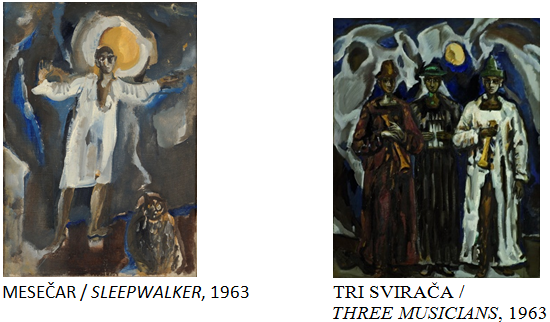

ZEPTER MUSEUM
Knez Mihailova street 42,
11000 Belgrade, Serbia
+ 381 (0) 11/ 328 33 39
+ 381 (0) 11/ 33 00 120
ENTRANCE FEE
200 RSD, 100 RSD, free
Opening hours
- Tuesdays, Wednesdays, Thursdays and Fridays
- 12 noon – 8 pm
- Saturdays, Sundays
10 am– 8 pm

